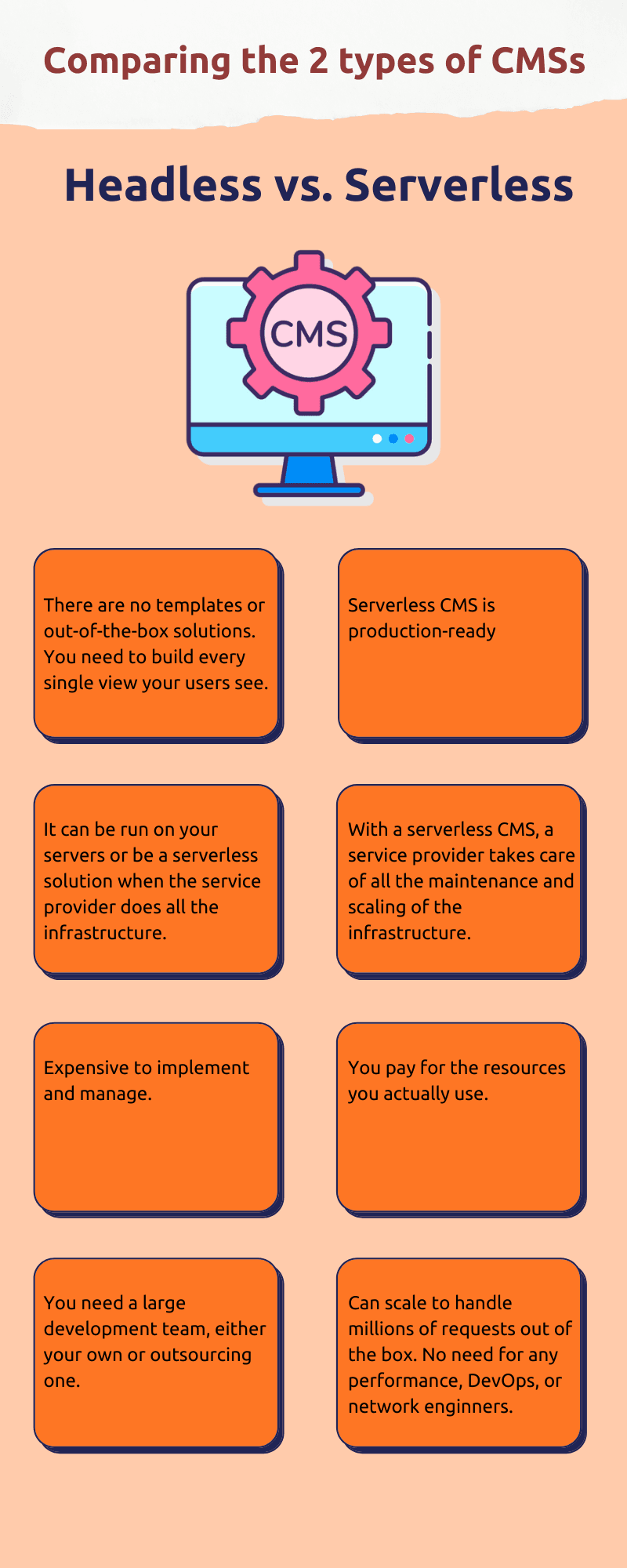There comes the point when the necessity of a CMS implementation becomes an integral part of your business. Especially if you plan to make major changes or switch to other scopes of products.
While Content Management Systems (CMS) have been around for a while, some significant advancements have been made in recent years.
A CMS is a software that assists in creating and managing information without the need to develop a website. You either don't work with code or write all of the code from scratch. The CMS takes care of all the primary infrastructure tasks like creating pages or storing images so that you can focus entirely on the content and its presentation.
Should you go with the newer headless content management approach or opt for a serverless system? Let’s explore the differences between the two approaches and find out which one is better for your project.
CMS Market: The Current State
Content management systems first appeared in 1985, undergoing a major shift in paradigm after the appearance of mobile Web 3.0.
Fast forward to the current time: with the rise of new and numerous devices such as smartwatches, gaming consoles, Amazon Echo, and Google Home, traditional CMS platforms cannot deliver content to all these channels in an efficient way. To answer the challenge, headless and serverless types of CMSs have arrived.
Today there are 4 types of content management systems:
- Traditional CMSs, also called “monolithic” or coupled. They have everything for displaying and managing content on the web, connected into a single system. It is meant to be used on the webpages and does a poor job when it comes to other channels.
- Headless CMSs. They act mainly as a content repository, and the content from there can be shown on any device via API. The display is separate and can be freely fine-tuned for any channel — from webpage to smartwatch to conversational interface.
- Serverless CMSs. Their main feature is that developers do not need to maintain servers themselves — the provider of serverless CMS does it for them. This type of content management system setup can come with either traditional architecture or with headless.
- Decoupled CMSs. This is a branch of traditional content management systems. The usual “monolithic” system is split and has its display part separated from the content management part. Decoupled CMS can serve content via API just like a headless one, and it also allows fine-tuning the display of content for any device and channel. But unlike headless CMSs, decoupled CMSs were not designed to work in this way from the beginning.
If you require assistance in making your decision, contact RabbitPeepers and benefit from our expertise.
What Is A Headless CMS?
A headless CMS is based on the idea that the “body” (the way to store and manage the content) is not tied to a specific “head” — the device or channel where the content is presented to a user.
With a traditional CMS, the content is meant for the webpage, and it would look worse or could not be shown at all somewhere else. But if it’s a headless CMS, the same content looks great on any device and channel — whether it’s a webpage, smartphone, smartwatch, or conversational interface.
Headless CMS can run on your servers or use a serverless setup. Choose your servers if you want full control over all data, but go with serverless if you want to scale fast.
The Stack for a Headless CMS
A headless CMS lets you use any technology stack you like to create a presentation layer. As a result, you can serve content to devices like mobiles, TVs, fridges, smartwatches, Google smart speakers, and others.
In simple terms, this is what it does. It gives editors an interface for uploading and editing content. That content is then distributed via API, and developers can take it and query and build applications with it.
Strapi, Webiny, Keystone, GraphCMS are examples of headless CMSs.
What Is Serverless CMS?
A serverless CMS is a content management system that is designed to run inside a serverless environment. Of course, it still uses servers. This means that you do not need to deal with server maintenance.
Availability, scalability, redundancy, uptime, orchestration, and all the other important things for modern web apps are all taken care of by the service provider.
Serverless is a cloud-based architecture that dynamically allocates machine resources. Whether you need manifold more power during peaking demand or entered a downtime — it would dynamically and appropriately manage everything without spending more of your time and money on it.
The Stack for a Serverless CMS
Serverless architecture can work with both traditional and headless CMSs. From the point of view of the structure, there are three parts:
- A backend hosted within a serverless function.
- A client part, which is usually hosted inside static storage (for example, Amazon’s cloud storage resource S3).
- There is also a special router, a gateway, located in front of these, whose role is to direct requests under the same domain to the correct parts of the system — a mobile device, a smartwatch, or something else.
ButterCMS, Sanity, Zesty.io, Kentico Kontent are examples of serverless content management systems.
Headless CMS vs. Serverless CMS: The Main Differences
Serverless and headless are two of the most commonly used terms in the world of web development. However, they’re two quite distinct concepts and practices—with their own, unique uses. Let's go over the distinctions between these two approaches, as well as how to get the most of them.

Due to these differences, each content management system has its own situations where it is suited best. Checking the pros & cons of each CMS will further help make the distinction clear.
Headless CMS: Pros & Cons
| Pros | Cons |
|---|---|
| * You can connect a single backend to multiple devices, and you get a lot of control over how your content looks to the user there. * It can run on your servers or be a serverless solution when all the infrastructure maintenance is done by the service provider. | If you go with headless CMS, you need to build every view your users see. There are no templates or out-of-the-box solutions. You need a large development team, either your own or on outsourcing. It’s expensive to implement and manage. There is no easy way to see content previews before it goes live. |
Serverless CMS: Pros & Cons
| Pros | Cons |
|---|---|
| * Serverless CMS is production-ready. * With serverless CMS, a service provider takes care of all the maintenance and scale of the infrastructure. * You pay only for the resources you actually use. * It can scale to handle millions of requests out of the box. No need for any performance, DevOps, or network engineers. * Some providers let you own and have full control over your data. It might also be possible to build custom apps and change any system part. | Some providers do not allow you to own and have any changes in how the system is run. No modification to the backend could be done. |
Why Are Headless And Serverless CMSs Used Together?
Traditional content management systems can’t meet the demand anymore, so the headless and the serverless rise to the occasion.
The headless CMS innovates how we retrieve and structure the data for a website, and the serverless is a change in how we run the infrastructure upon which a website runs.
Since a serverless content management system can also be “headless” at the same time, the benefits of both CMSs can be combined to get the best out of them.
It eliminates the need to choose and pick between the two and brings a much larger set of applications to the table. More complex websites, APIs, microservices, and web applications become possible.

Headless CMS or Serverless CMS: What to Choose For Your Project
A good CMS is required in various business areas. You'll need a sophisticated and dependable content management system to meet your project requirements. The properly chosen CMS will provide the necessary ease of use, features, security, and third-party integration. For your website, the content management system will also offer SEO compatibility, responsive design support, analytics tracking, content personalization for target audiences.
Before choosing between a headless CMS and serverless CMS, you need to consider some factors to achieve dynamic, content-rich sites.
- The reasons for replacing your legacy CMS.
- The cost (in time, money, and workforce) of the change, and if you are willing to invest.
- The audience that will use the CMS.
When it comes to your legacy CMS, there are some reasons why you might want to replace it. For example, your business needs functions that your current CMS does not have. The legacy CMS might have hidden running costs, making it more expensive to use long-term.
Due to constant changes in the software market, the legacy content management system sometimes can’t efficiently integrate with other modern tools you’d like to use. The market is adopting new trends, so integrating a powerful and functional CMS will help you grow your business.
Competitive website development doesn’t happen by accident. Here at RabbitPeepers, we work with both headless and serverless architectures and can bring the experience and knowledge you need to get (and stay) ahead of your competitors.
So, what is the best CMS for your project or business? We hope our recommendations will help you with your preference.
Choose headless if:
- You have a big team of developers or can outsource the work.
- You need to reach your users on multiple devices and channels and want to create a unique user experience.
- You need a CMS that can scale easily.
- You are fine with using a variety of technologies.
- You don’t require content previews before it goes live.
Choose serverless if:
- You are fine with having little or no control over servers.
- You want a solution that can scale up and down quickly and cost-efficiently.
- The computations you run are short and won’t go over the provider’s time limit.
- Your applications have short throughput (not too many requests per second), or they have high throughput, but the other advantages of a serverless CMS still make it worth it for you.
- You’d like to do prototyping or preview content before it goes live.
Decoupled CMS: The Best Of Both Worlds
A fair number of traditional content management systems tried to go headless or serverless too, and these modifications gained the name “decoupled CMS”.
WordPress, EpiServer, SiteCore, Drupal all have their own ways to achieve it. The world’s most popular content management system, in particular, uses REST API that was bundled into its core and plugins to decouple itself from its front-end.
The resulting headless WordPress gets omnichannel delivery, improves security, saves time, and frees the developers from technology stack restrictions.
At the same time, many benefits of a traditional CMS (think website preview, SEO functionality, updates) are lost when it disconnects its front-end. In addition, developers now need to deal with two separate things: WordPress on the backend and a separate app on the front end.
Headless e-Commerce
Another example is headless Shopify, a robust e-commerce platform used by 3.76 million stores. It was originally a serverless, SaaS-based system, but there is also a headless version of the platform that gives you more control.
How does this headless e-Commerce work?
The traditional option is to use Shopify to command the whole shop, including a checkout process. Your design will then rely on Shopify’s out-of-the-box functions and templates. It’s an easy, no-hassle solution. The issue is that adjustments to the checkout flow you could do with this option are limited.
The headless approach example is to design your checkout flow yourself. There is a lot of freedom here — literary every pixel of every view is under your control. Of course, the backend — financial transactions — is still handled by Shopify.
If you're looking for commerce platform development powered by Shopify's, we're always eager to assist. No matter what level of complexity the project is, our company successfully works with any type of project.
Final Thoughts
Users' judgments on website reliability are 70% based on general aesthetics, usefulness, and convenience. People like helpful and straightforward products that meet their needs.
Headless CMSs provide a simple way to manage content while the developers get API together, making it easier and faster to store, edit, and publish content. Serverless CMSs free businesses from managing servers’ infrastructure. Decoupled CMS is a good choice when you don’t want to invest in an actual headless structure but are restricted too much by traditional platforms.
RabbitPeepers is happy that our clients choose and trust us to improve their business performance and growth. If you still have any questions, our team of specialists will help you deal with all the issues related to a CMS or any other specific development challenge.


